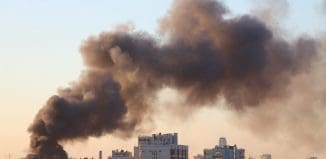Jihadi organizations’ global activity in the second week of February 2015
This post is also available in:  עברית (Hebrew)
עברית (Hebrew)

Senior official of Al-Qaeda in the Arabian Peninsula (AQAP) killed in a targeted killing
Harith al-Nadhari, one of AQAP’s most prominent authorities on Islamic religious law, was killed in a targeted killing carried out by means of a US drone. Three of his escorts were killed along with him. The targeted killing took place in the Shabwa province, in southern Yemen, on January 31, 2015. AQAP confirmed the report (Al-Arabiya TV, February 5, 2015; Al-Sharq Al-Awsat, February 5, 2015).
In a recent video, Harith al-Nadhari listed the necessary conditions for carrying out suicide bombing attacks. In an audiotape released on January 9, 2015, al-Nadhari claimed responsibility on behalf of AQAP for the attack in Paris on the newspaper Charlie Hebdo (YouTube, January 9, 2015).
Libya: Call on jihadi organizations in North Africa to join ISIS
ISIS’s “Tripoli province” in Libya, which claimed responsibility for the attack at the Corinthia Hotel, recently posted a video on a jihadi website. The video was issued by the “information office of the Tripoli province”. The codename of the speaker in the video was Abu Suleiman al-Tareqi. In the video, he addresses (in Tuareg, one of the Berber languages) the “brothers” in Libya, Mali and Algeria,calling on them to pledge allegiance to the Islamic State and to practice jihad. Another speaker, codenamed Abu Umar al-Tareqi, addressed the “brothers” from the Tuareg tribes and called on them to pledge allegiance and emigrate to the Islamic State. These calls may indicate ISIS’s intention to expand the areas of its influence in North Africa beyond Libya, where it has gained a foothold.
Stabbing attack in France
On February 3, 2015, three French soldiers were attacked with a knife in Nice, in the south of France, while guarding the Jewish community center. The three soldiers were slightly injured. The attacker was caught and arrested.
The attacker is Moussa Coulibaly, around 30, from a family of immigrants from Mali. He has a criminal record (property and violent crimes). About a week before the stabbing attack in Nice, Moussa Coulibaly was deported from Turkey to France. He was detained and questioned by the French intelligence services on suspicion of planning to join the jihadi terrorist organizations in Syria. After being questioned, he was released and he then carried out the stabbing attack in Nice.
Register to iHLS Israel Homeland Security
The battle for hearts and minds
ISIS offers a reward to anyone who murders Jordanian pilots
On February 4, 2015, an Islamic forum published a manifesto on behalf of the Islamic State’s general security bureau. The manifesto included a detailed list of Jordanian pilots, including the rank, place of residence and position of some of them. The general security bureau of the Islamic State of ISIS said that the Shura Council of the Islamic State had approved a financial reward of 100 gold dinars to anyone who kills or injures a Jordanian pilot, so that he is unable to fly or work within the coalition against ISIS. The source of this list, according to the Islamic State’s general security bureau, is a result of the interrogation of the Jordanian pilot Muadh al-Kasasbeh (Shabakat al-Jihad al-Alami Forum, affiliated with the global jihad, February 4, 2015).
Propaganda video with abducted British journalist John Cantlie
On February 9, 2015, forums affiliated with ISIS posted a new video with abducted British journalist John Cantlie, who has been utilized by ISIS in the past for propaganda purposes. The video covers the situation in Aleppo and its surroundings, but most of the photos appear to be from the city of Al-Bab, east of Aleppo, and not from the city of Aleppo itself (probably in order to create the false impression that ISIS has complete control of the city and its environs).
John Cantlie described the extensive destruction created in and around the city by the aircraft of the Syrian regime with, so he says, the assistance of American drones. He noted that a large part of the city, with its ancient architectural heritage, had been destroyed and that many of its residents had fled. On the other hand, Cantlie praised the services that the Islamic State provides to the residents for maintaining their daily routine. In the video, Cantlie is shown with groups of children who attend religious studies and is shown telling the camera: “These kids will form the Mujahideen of the next generation.” (shabakataljahad.net, February 9, 2015).
Computer game to encourage fighting in the Iraqi Army and the Peshmerga
On February 1, 2015, a forum affiliated with ISIS posted a report about an online computer game where players can choose ISIS forces and fight in the Iraqi Army and the Kurdish peshmerga forces. The ISIS forces include high-quality graphics and look very realistic. The game, called ARMA (Armed Assault), is a tactical computer game for up to 40 players in each group. The game was released in 2006 by Czech computer game developer Bohemia Interactive (forum affiliated with ISIS, February 1, 2015).
Written by: The Meir Amit Intelligence and Terrorism Information Center (ITIC)





























